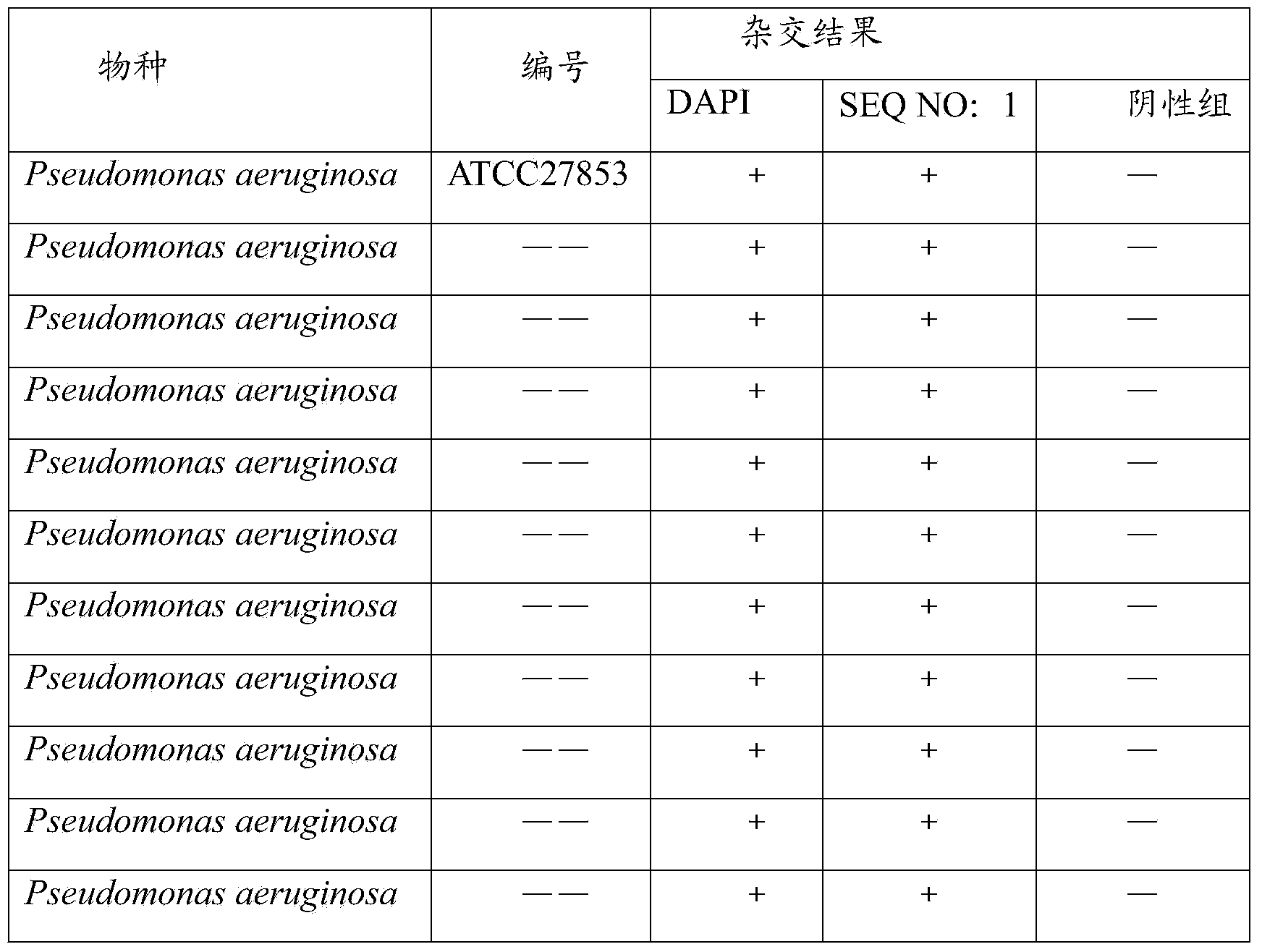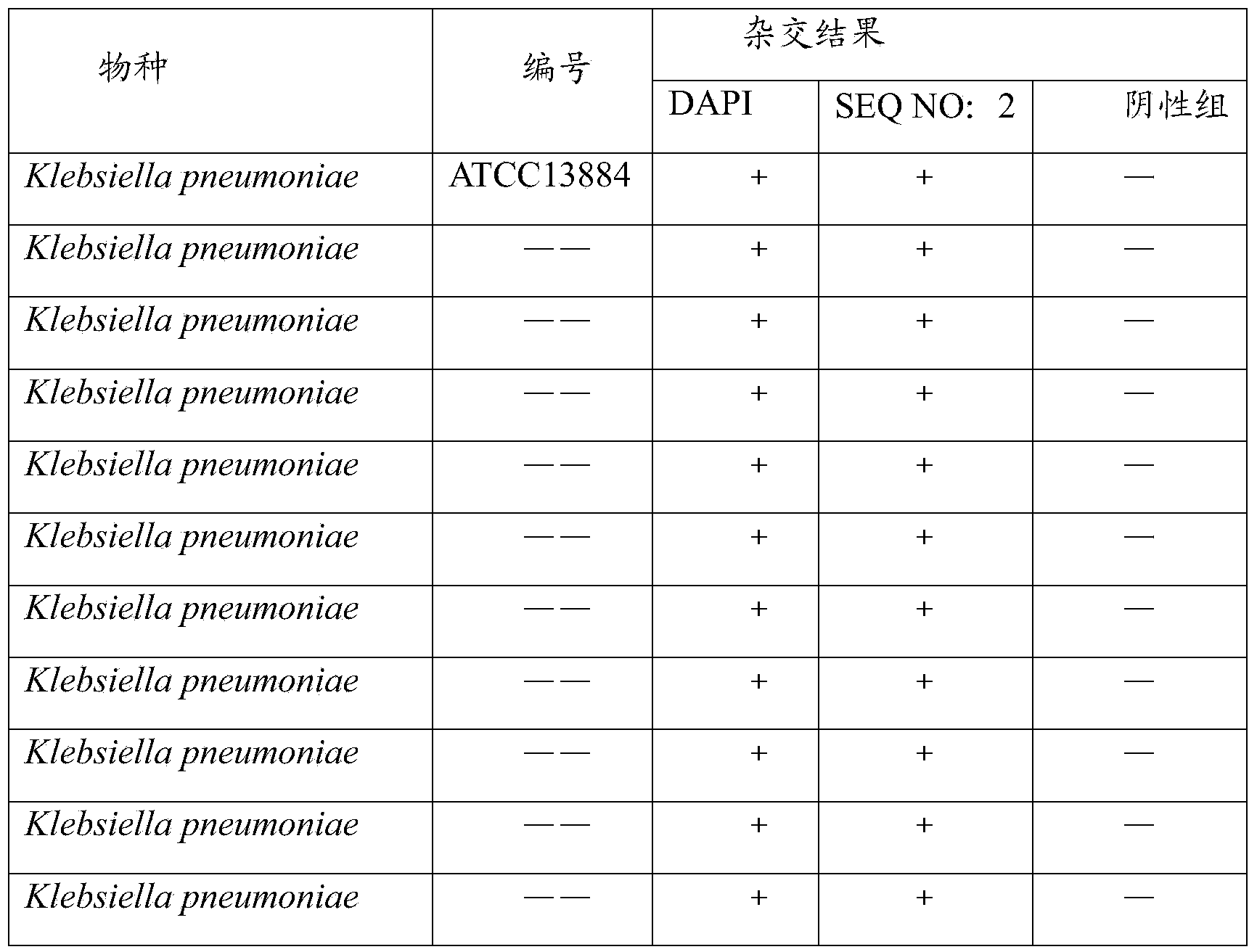Peptide nucleic acid probe set and kit used for detecting pseudomonas aeruginosa, klebsiella pneumoniae and/or baumanii
A technology of Pseudomonas aeruginosa and Acinetobacter baumannii is applied in the detection field of clinically related microorganisms, which can solve the problems of high false positives, time-consuming and labor-intensive, complicated steps, etc., and achieves reduction of false positives, ensuring environmental sanitation and sensitivity. high degree of effect
- Summary
- Abstract
- Description
- Claims
- Application Information
AI Technical Summary
Problems solved by technology
Method used
Image
Examples
Embodiment 1
[0109] Example 1, PNA-FISH sensitivity verification
[0110] PNA probe:
[0111] Alexa488-O-CTG AAT CCA GGA GCA (SEQ NO: 1)
[0112] Alexa546-O-CAC CTA CAC ACC AGC (SEQ NO: 2)
[0113] Alexa350-O-GGC CAG ATG GCT GCC (SEQ NO: 3)
[0114] Sensitivity validation was performed on different subspecies of Pseudomonas aeruginosa, Klebsiella pneumoniae and Acinetobacter baumannii. The experimental procedure is described below.
[0115] bacterial strain
[0116] The bacterial strains were clinical isolates and reference strains obtained from the American Type Culture Collection (ATCC). One drop of each strain culture was added to a glass slide and left to dry at 55°C.
[0117] fixed
[0118] To prevent loss during 16S rRNA hybridization, samples were immersed in 4% paraformaldehyde (wt / vol) and 50% ethanol (vol / vol) solutions for 10 minutes each.
[0119] hybridize
[0120] In this step, a drop containing 10% (wt / vol) dextran sulfate, 10mM NaCl, 50% (v / v) formamide, 0.1% (wt / v...
Embodiment 2
[0137] Example 2 PNA-FISH specific verification
[0138] Select other pathogenic bacteria such as Pseudomonas aeruginosa, Klebsiella pneumoniae, and Acinetobacter baumannii, including common pathogenic bacteria such as Staphylococcus, Enterococcus, Escherichia coli, and the test steps and methods are as in Example 1 mentioned.
[0139] The results showed that the probes SEQ NO: 1-3 could not bind to non-target strains (Table 6). Consistent with the expected results, SEQ NO: 1-3 have good specificity.
[0140] Table 6 PNA probe specificity verification
[0141] species Numbering SEQ NO: 1 SEQ NO: 2 SEQ NO: 3 Pseudomonas aeruginosa ATCC27853 + - - Klebsiella pneumoniae ATCC13884 - + - Acinetobacter baumannii ATCC19606 - - + Staphylococcus epidermidis ATCC12228 - - - Staphylococcus aureus ATCC29213 - - - Staphylococcus aureus ATCC25923 - - - Enterococcus faecalis —— - - - Escherichia coli...
Embodiment 3
[0143] Embodiment 3 drug susceptibility test
[0144] Quality control strains of Pseudomonas aeruginosa, Klebsiella pneumoniae and Acinetobacter baumannii were selected from different drug-sensitive Pseudomonas aeruginosa, Klebsiella pneumoniae and Acinetobacter baumannii isolated from the hospital The strains were subjected to a drug susceptibility test, and the test steps and methods were as described in Example 1, and the K-B method was used as a positive control for each test. The results are shown in Tables 7, 8 and 9.
[0145] The results show that the present invention can better detect the drug sensitivity of the target strain.
[0146] Table 7 Pseudomonas aeruginosa drug susceptibility test
[0147]
[0148] Note: A: fluorescence ratio method; B: K-B method; S: sensitive; I: intermediate; R: resistant
[0149] Table 8 Klebsiella pneumoniae drug susceptibility test
[0150]
[0151] Note: A: fluorescence ratio method; B: K-B method; S: sensitive; I: intermedi...
PUM
 Login to View More
Login to View More Abstract
Description
Claims
Application Information
 Login to View More
Login to View More - R&D
- Intellectual Property
- Life Sciences
- Materials
- Tech Scout
- Unparalleled Data Quality
- Higher Quality Content
- 60% Fewer Hallucinations
Browse by: Latest US Patents, China's latest patents, Technical Efficacy Thesaurus, Application Domain, Technology Topic, Popular Technical Reports.
© 2025 PatSnap. All rights reserved.Legal|Privacy policy|Modern Slavery Act Transparency Statement|Sitemap|About US| Contact US: help@patsnap.com



